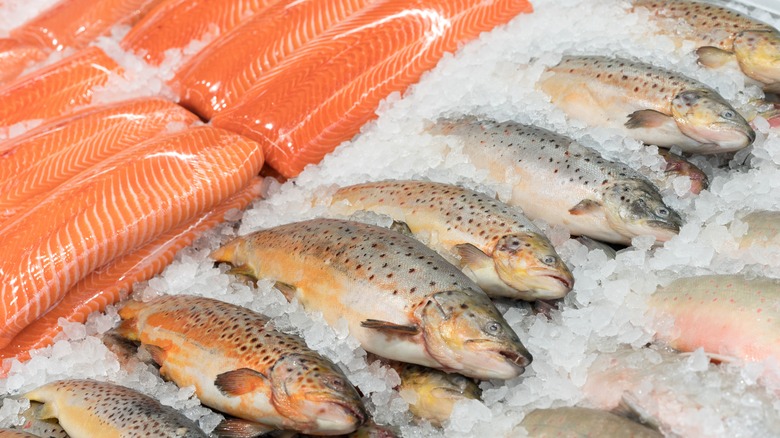The Simple Spoon Hack That Makes Descaling Fish A Breeze
Americans love their seafood. In 2021 alone we ate 20.5 pounds of fish per capita, and demand for seafood is only growing. If you're getting on board with more fish in your diet, it's only a matter of time before you have to address a dreaded task that's unique to fin fish: descaling. Whole fish, or fish with the fins and skin still attached, are often sold with the scales, which is a cheaper way to buy fish, but it's up to you to scrape these protective pieces away before you cook it. Before you spend any money on a special descaling tool, however, there's an easier hack: Grab a teaspoon out of your silverware drawer.
Fish scales are the animal's natural defense against threats like predator bites, parasites, and general wear and tear that comes from swimming around in open water, but they're pretty unpleasant to eat. The good news is that it's really easy to get them all scraped off in just a few minutes, and a regular everyday teaspoon will prevent you from damaging any of the precious meat underneath.
Save money on seafood by buying whole fish
It seems like everyone's eating more fish these days because they know it's a great source of lean protein. A typical 6-ounce filet of salmon, for example, packs 34 grams of protein and 22 grams of fat, not to mention it's rich in omega-3 fatty acids, which are good for heart health.
However, there's no denying that fish is expensive, and that probably isn't going to change in the foreseeable future. The cheapest way to buy fish, if you have the storage for it, is whole. That's because every time someone touches a fish to make it easier to eat, the price goes up. That's why an uncut side of salmon with the skin on costs less per pound than pre-cut individual, skinless filets. The catch is that you have to descale it yourself, but don't worry, it's a lot easier than you might think.
Use a spoon for descaling
To descale a whole fish, start by putting it in a clean sink so you don't make a big mess. Grab a teaspoon in one hand and the tail of the fish in the other, and scrape the scales off from the tail toward the head. If you find that the fish is too slippery to get a good grip, try wrapping a kitchen towel around the tail. If you're attempting to descale a cut piece of fish, figure out which direction the scales are going and simply scrape in the opposite direction. The scales will pop right off while the spoon skims over the meat without ripping or tearing the flesh. Once you get all the scales removed, give the fish a quick rinse under the tap, and it's ready for cooking. Just don't throw away your wild-caught salmon skin, as it packs a hefty nutritional punch.
Depending on the size of the fish, descaling only takes a few minutes, and it's definitely worth it to learn this simple skill. But if you're really squeamish about descaling, most fish handlers will scrape away the scales for you if you ask them. Plus it always pays to get to know your local fishmonger because they can keep you in the know on what's fresh and in season.


